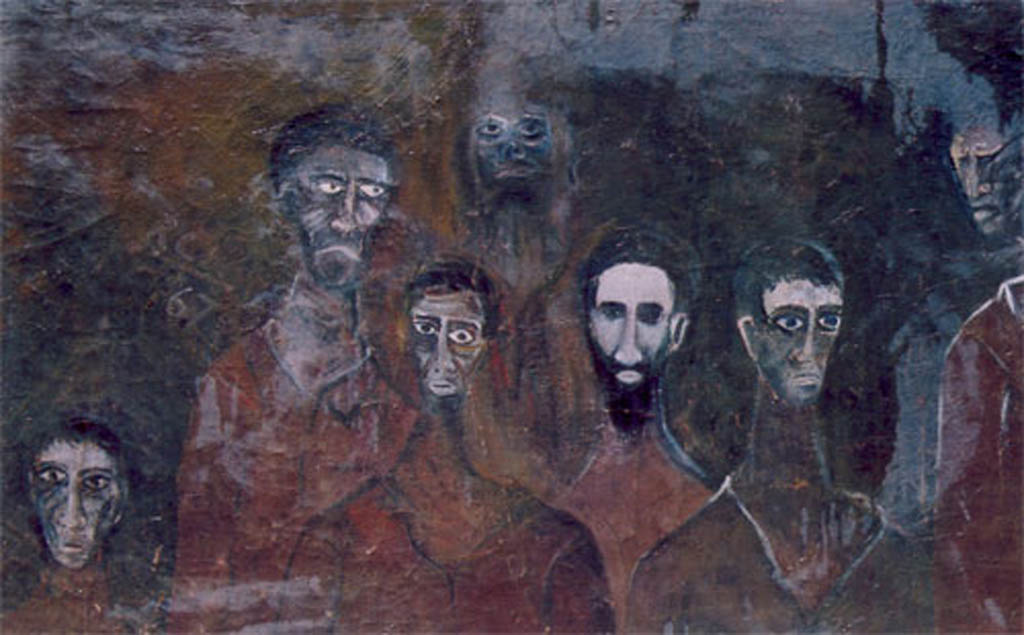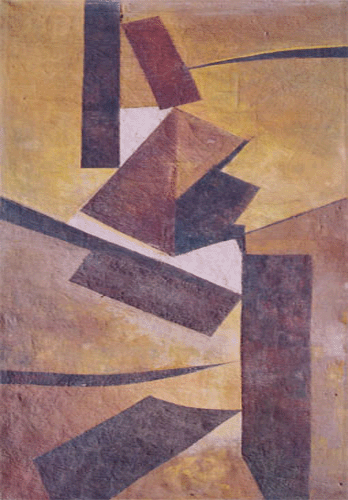Roop Chand
Number 550, Sector 10, Chandigarh a corner house with a small wooden gate leading to a handkerchief size garden minus grass stood unlike many big mansions in the neighborhood. Big glass panes were covered with the tie and dye curtains. Paintings added the colour and life to the sitting room that had books on Art history piled up on a rickety book rack. Few pieces of furniture – bamboo chairs woven with cords and raw-wood coffee table were all made by the artist who lived in this house in late 60’s. Yes, this was the house cum studio of Roop Chand.
Roop Chand was lecturer at the Home Science College in the same sector and his studio was the meeting place of many accomplished artists, art critics, university professors and ambitious students. He came to Chandigarh to serve as a teacher after having completed his education. Under the presidentship of Sh Narhari Vishnu Gadgil the governor of Punjab, he established Bal Bhawan where he trained the students in painting and clay modelling. His professional graph helped him move to Govt. College for Girls and later to Home Science College. Greatly influence by Dr. Mulk Raj Anand, Roop Chand dedicated his time in experimenting with art trends and became a voracious reader.
Home Science College, Art department under his headship was a hub of creativity. Miss Sherie Doongaji, the principal of the college herself an art lover, provided an ideal environment for Roop Chand to work extremely hard and pass on the knowledge to his students. A bohemian in many ways, his kind attitude encouraged the students to get a platform to explore. Fondly addressed as ‘Artoo’, every student gave him respect and found a guide in him.
It was during this time that Roop Chand founded ‘Upsurge’ group which included Sohan Qadri, Rania, Sumant Shah, Shiv Singh, Aditya Prakash, S S Datta. Many young artists like Vinod Bakshi, Goldy and Pimmi Khanna joined in the following exhibitions. Art movement was being felt by the Chandigarhians as the capital was getting prominence on the art scene. Dr. Randhava’s concrete help in establishing the artists gave a further boost.
According to Roop Chand, his golden period was his stay at Home Science College where he opened his wings to fly higher. Home science college helped Roop Chand to reveal his several facets like stage-set designing for ballets, flower arrangement, textile designing, collage making out of waste material, furniture designing, pottery and ceramics. College also gave him an opportunity to meet and interact with artists of repute like Prithviraj Kapoor, Damyanti Joshi, Begam Akhtar, Pt Ravi Shanker, Ustad Bismillah Khan, Sharan Rani and Zubin Mehta.
His paintings of this period were figurative and abstract, mostly working with mono-chromatic colour palette his strokes were bold and firm. The huge canvases captured contemporary themes like creation of Bangladesh and student unrest in different parts of the world. At the same time creation of Haryana as a new state got him involved in the cultural traits of the state and he organized an exhibition titled ‘Sanjhi Shakti’. This involved him in conducting workshops in other parts of Haryana. The series of exhibitions held during his stay at Chandigarh were ‘Time and Space’, ‘Action in Time and Space’, ‘Age of Anxiety’ and ‘Bindu Beginning’. The tireless dedication of Roop Chand produced two murals in Haryana and a monumental sculpture of the first president of India at Kurukshetra University.
Being a true bohemian, he never thought twice before giving up his teaching career at Chandigarh to explore art trends outside India. After travelling in parts of Europe and Middle East he landed in Denmark. He continued his ‘Bindu’ series here and exhibited at various places and gave lectures on Indian Art.
The strong pulls of his motherland made him start a studio and Art Centre at his native village Dundahera. Designed on a higher plinth, the multipurpose room has a studio in the basement. At one time surrounded by tall eucalyptus trees this Art Centre is now in the busiest business hub of Gurugram. This National Art Centre established by Roop Chand has been a unique contribution for providing training to upcoming artists and chance to exhibit their works. Several art activities, competitions and exhibitions have become a regular feature.
At this studio Roop Chand continued to paint the series – ‘Bindu Memories’, ‘Homage to Women’ and many landscapes titled – ‘I Hail You The Himalayas I Hail You The Indian Ocean’. With years adding to the experience, he took to writing on serious subjects along with poetry and fiction in Hindi and English. Very few in Chandigarh knew that Roop Chand used a pseudonym ‘Vayathit’ (व्यथित) and penned many poems and short stories. Painting took most of his time and this love for writing surfaced prominently at the Art Centre . He has more than half a dozen books to his credit.
It would have been extremely unusual if Roop Chand had reached this phase of peace and tranquility without passing through intense turmoil and tension. His selflessness has helped him reach this encompassing vision of ‘Bindu Meditation’. Roop Chand has many awards and houours to his credit including the Haryana Gaurav Award.
Now this Art Centre is like a hermitage for him and his heart of gold yearns for the students to pick up details on creativity from his vast and rich experiences.
Roop Chand has always been sharing his views with the students on not to ape the Western art. He strongly feels that abstraction and symbolism are the essence of Indian art that West has learnt from us.
I can never forget the help and guidance he gave me while working on a mural(12’x10′) for our Chandigarh house. Right from the making of a kiln, clay preparation, glaze grinding to firing and fixing it on the front facade, it was a life time lesson for me. Not only on mural making but also to pick up tips on laborious hard-work and patience. Only my ‘guru- dost’ could do so much.
A true polymath, incomparable and ultimate bohemian advises the young artists ‘listen to your heart and follow that path, heart never lets you down’.
So much like Rumi’s words –
‘My heart do not complain,
don’t speak of this and that, go beyond the impressions, look only
for the essence.’








